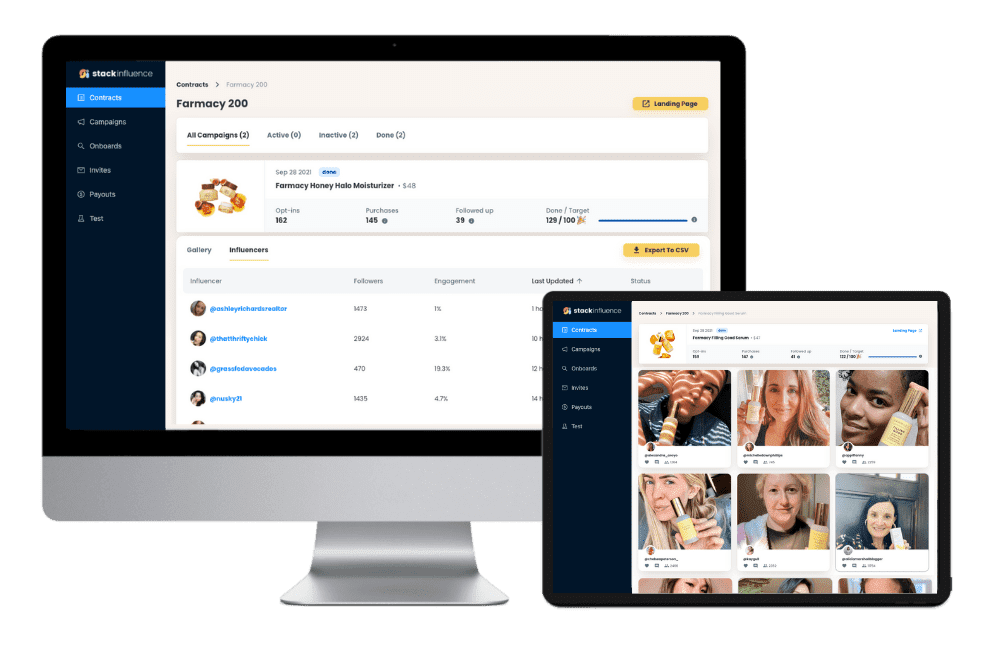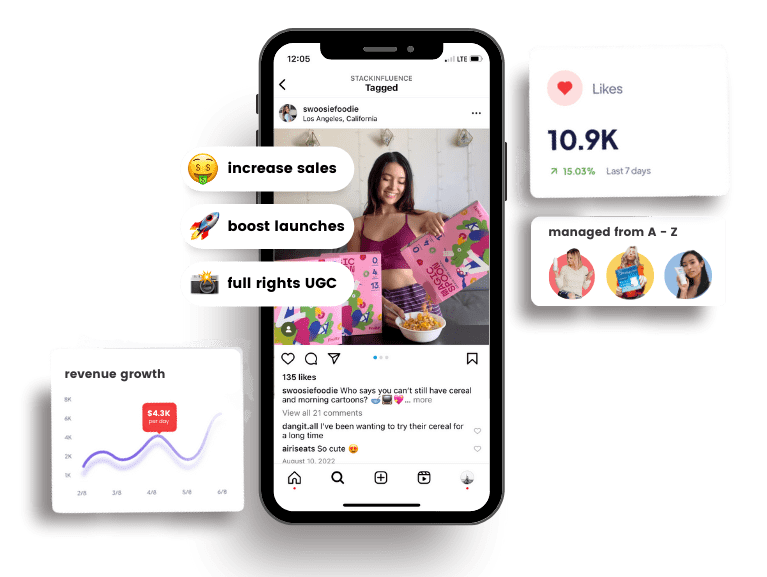How to Find Micro‑Influencers: The Ultimate Guide for E‑Commerce & Amazon Sellers
17th
August, 2025
Influencer Marketing
Amazon Marketplace
Artificial Intelligence
TikTok Tips
Micro-influencers are the hidden gems of the social media world. These are content creators with relatively small followings (often in the thousands to low tens of thousands) who have outsized influence in their niches. They might not be celebrities, but they’re passionate, relatable, and highly trusted by their communities. For small e-commerce brands and Amazon sellers, partnering with micro-influencers can be a game-changer: it’s like tapping into word-of-mouth marketing at scale, powered by genuine user-generated content (UGC). In fact, over 72% of teenagers follow influencers and trust their product recommendations, highlighting how much sway these creators have in shaping buying habits.
Unlike mega influencers with millions of followers, micro-influencers typically have anywhere from 1,000 up to 100,000 followers on a platform. What makes them special is their tight-knit bond with their audience – they interact with followers, focus on specific niches, and come across more like a knowledgeable friend than an advertisement. This means their posts often get a much higher engagement rate (sometimes 5%–8% of their audience engages, versus the ~1–2% typical for macro-influencers). And more engagement isn’t just a vanity metric; it translates to real conversations, trust, and often better sales conversion rates from their recommendations. No wonder brands are flocking to micro-influencer campaigns – on average, businesses are seeing around $5.78 in earned media value for every $1 spent on influencer marketing. That’s an impressive ROI that even small budgets can get behind.
In this comprehensive guide, we’ll walk through why micro-influencers matter for small businesses and then get into how to actually find micro-influencers who can boost your brand. We’ll cover everything from social media hashtag sleuthing to specialized influencer platforms (including why Stack Influence is one of the best ways to find micro influencers). Whether you’re an Amazon seller looking for content creators to feature your product, or an e-commerce startup seeking authentic UGC to build trust, we’ve got you covered.

Unlock the Power of Micro Influencers and Elevate your Brand Today!

Why Micro‑Influencers Are a Big Deal for Small Businesses
Micro-influencers may be “micro” in audience size, but they can have a macro impact on your marketing. Here are some key reasons small e-commerce brands and Amazon sellers should care about micro-influencers:
-
Authenticity & Trust
Micro-creators often come off as regular people and genuine fans of the niches they discuss. Their endorsements feel authentic, like advice from a friend, which consumers trust more than traditional ads. For example, 50% of millennials trust product recommendations from influencers, vs only 38% who trust celebrity endorsements. This trust factor translates into real results – micro-influencers bring ~60% more trust to a brand and drive 20% higher conversion rates compared to macro-influencers. In short, a shout-out from a micro-influencer can carry serious credibility with potential customers.
-
Higher Engagement Rates
When micro-influencers post, their followers respond. Studies show micro-influencers (tens of thousands of followers) often see 3–8% engagement on their posts, far above the meager ~1% engagement typical for big influencers. More likes, comments, and shares mean the audience is truly paying attention. An engaged audience is more likely to click through, learn about your product, and ultimately become a customer. (Ever notice how a micro-influencer’s comment section feels like a community discussion? That’s the kind of engagement big names struggle to achieve.)
-
Cost-Effective Marketing
For small businesses, budget is a big concern – and here micros shine. Micro-influencers are much more affordable to work with than major influencers. Many will collaborate in exchange for a free product sample or a modest fee, especially if they genuinely like your product. You won’t have to shell out tens of thousands on a single post. This means you can engage multiple micro-influencers for the price of one macro-influencer, spreading your reach and diversifying content. Because their audiences trust them more, you often get more bang for your buck (in terms of engagement and conversions) with a micro-influencer campaign.
-
Valuable UGC Content
When a micro-influencer posts about your product, you’re not only getting exposure – you’re also getting user-generated content (UGC) that you can reuse in your own marketing. Think unboxing videos, how-to demos, before-and-after photos, stylish shots of your product in real life, etc. This authentic content resonates with consumers and builds social proof for your brand. You can repurpose UGC in your social media, on your product pages, or even in ads to add that real-customer vibe. It’s like hiring a content creator and brand ambassador in one. (Fun fact: short-form videos from micro-influencers on TikTok/Instagram are in high demand by brands to repurpose as ads!)
Average engagement rate on Instagram: Micro-influencers (~10k–100k followers) see about 3.9% engagement per post, whereas macro-influencers (100k+ followers) only get roughly 1.2%. Micro influencers’ close-knit communities interact with their content at a much higher rate, indicating stronger influence and interest.
Survey of marketers on ROI: 56% reported better ROI with micro/nano-influencer campaigns, versus 44% who saw better results with macro or celebrity influencers. The majority lean towards micro-influencers as the more cost-effective and impactful choice for marketing ROI.
Now that we’ve covered why micro-influencers are such a powerful asset – delivering authentic recommendations, higher engagement, and great content on a budget – let’s get into the real question: how do you find these micro-influencers for your own brand? Below, we’ll outline step-by-step strategies to discover and connect with the right creators for your niche.

Unlock the Power of Micro Influencers and Elevate your Brand Today!

How to Find Micro‑Influencers for Your Brand
Finding the right micro-influencers takes a bit of detective work, but it’s not as hard as it may seem. Small businesses and Amazon sellers can use a mix of social media sleuthing, online tools, and creative thinking to uncover great micro-influencer partners. Here are some proven methods:
1. Define Your Niche and Choose Key Platforms
Before you start searching, get clear on who you’re looking for. What niche or industry does your product fall into, and who is your target audience? The best micro-influencer for your brand is someone who talks about topics aligned with your product and appeals to the customers you want to reach. Once you know your niche, consider which social media platforms are most popular in that space. For example:
- Lifestyle, fashion, beauty, food – Instagram and TikTok are hot spots (Instagram alone boasts 2+ billion users and is a top platform for lifestyle influencers, while TikTok’s billion+ users excel at making products go viral).
- Tech, gaming, how-to content – YouTube might be a goldmine, since creators there can do in-depth reviews and tutorials.
- B2B or professional niches – LinkedIn or Twitter could house micro-influencers (though these might be more “industry experts” than typical influencers).
- Amazon products of any kind – Amazon has its own influencer program (more on that later), but those influencers often promote on Instagram, TikTok, and YouTube as well.
Choosing the right platform helps focus your search. If you sell a photogenic home décor product, Instagram and Pinterest are obvious choices. A cool new gadget might shine on TikTok or YouTube. Go where your audience hangs out and where people naturally share content about products in your category.
2. Leverage Social Media & Hashtag Searches
One of the most straightforward ways to find micro-influencers is by searching social media for content in your niche. Start with Instagram and TikTok, as these are fertile ground for product recommendations and trendsetters:
- Use Niche Hashtags: On Instagram, try searching hashtags related to your product or niche – e.g., #OrganicSkincare, #FitnessGadgets, #DIYCrafts. Scroll through recent posts and see who’s posting regularly and getting engagement. If someone consistently talks about your niche and has a few thousand followers, they might be a great micro-influencer to approach. For product-centric content, also check tags like #AmazonFinds, #AmazonHaul, #MustHaves etc., which are commonly used by creators sharing cool products. Often, micro-influencers will mention in the caption or bio if they have an Amazon storefront or a discount code – clues that they collaborate with brands.
- Check Trending Tags: TikTok has its own set of viral tags. For example, #TikTokMadeMeBuyIt is notorious for showcasing products (many from Amazon) that blew up thanks to TikTok. Searching that tag (and niche tags like #AmazonFinds on TikTok) will surface creators making short, viral product videos. If you find someone reviewing or unboxing a product similar to yours, check their profile – what’s their follower count? Do they call themselves a “shopaholic” or “Amazon finder” in their bio? Those are signs of a micro-influencer who might love your product too. On both IG and TikTok, spend time scrolling through these tags and take notes of any creators that seem like a fit (note their username, follower count, engagement level, and content style).
- Look at Comments and Communities: When you find a potential micro-influencer, see who’s engaging with their posts. Other micro-creators often follow and comment on each other. You might discover more influencers by looking at the comments – it’s like pulling a thread. Also, some niche communities have their own specific hashtags or group chats (e.g., #Bookstagram for book lovers, #CleanBeauty for green cosmetics). Tapping into those will reveal the active voices in the community.
By actively searching and scrolling, you can uncover countless micro-influencers organically. It’s a bit manual, but it’s free and highly targeted – you’re finding people who are already talking about your niche. As you gather a list, be sure to check that their follower count roughly fits the “micro” range (there’s no hard rule, but 5k to 50k is a good ballpark for many industries) and that their engagement looks healthy (if they have 10k followers but only 5 likes on a post, that’s a red flag – their audience might be fake or unengaged).
3. Search YouTube and Blogs for Niche Content
Don’t overlook longer-form content platforms like YouTube, and even blogs or Pinterest, depending on your niche. Many micro-influencers expand beyond just Instagram. For example, a tech gadget micro-influencer might run a YouTube channel with “Top 5 Amazon Gadgets” videos, or a DIY craft influencer might have a blog that showcases projects and products.
- Find “Best of” or Review Videos: Head to YouTube and search for terms related to your product category plus words like “review”, “haul”, “favorites”, or “must-haves”. For instance, if you sell kitchenware, search “Amazon kitchen gadgets haul” or “best cookware 2025”. You’ll likely find videos where creators (not necessarily huge YouTubers) share a bunch of products. Many Amazon-focused influencers post “Amazon Favorites” or “Amazon Must Haves” videos. Check these out and note the channel names. Even if their subscriber count is modest (say 2k, 10k, 50k), if their content is on-point for your niche, they could be a valuable micro-influencer. Noticed a familiar face in a video but can’t find their socials? With Face Search, you can identify them across multiple platforms in seconds and get direct links to their Instagram or TikTok.
- Check Video Descriptions for Links: A pro tip – YouTubers who are part of the Amazon Influencer or Affiliate program will almost always include their Amazon storefront link or affiliate product links in the video description. Look for text like “My Amazon Storefront: amazon.com/shop/[name]” or a list of product links (which often include “amazon.com” in the URL). If you see that, you’ve struck gold: that creator likely has an Amazon influencer storefront and is actively looking to earn from product recommendations. They might be very open to featuring your product. Even if they don’t list a storefront, a YouTuber who frequently reviews products is worth considering – you might search their name on Instagram or TikTok to see if they have a presence there too.
- Explore Blogs and Pinterest: In some niches (like food recipes, home decor, fashion), bloggers or Pinterest influencers may not have huge IG followings but do have engaged audiences on their own sites or Pinterest boards. Searching Google like “best [your product type] blog” or looking at Pinterest pins for your category could reveal bloggers who do product round-ups. Many bloggers are micro-influencers who would happily review a product if you reach out. They often also have accompanying Instagram/Pinterest followings in the micro range.
4. Use Influencer Marketing Platforms (Databases)
If manual searching feels like finding a needle in a haystack, don’t worry – there are tools that make finding micro-influencers much easier. Influencer marketing platforms are online services that connect brands with thousands of influencers. They often let you search by niche, follower count, engagement rate, audience demographics, keywords, etc., making it simple to filter out the big celebrities and zero in on micro-influencers who fit your exact criteria.
One standout example is Stack Influence, an influencer marketing platform focused on micro-influencers for e-commerce brands. Stack Influence (built by experienced Amazon sellers) provides an AI-vetted network of micro and nano influencers specializing in all sorts of niches. Using a platform like this can be a huge time-saver – instead of hunting on Instagram for hours, you can input your niche (say “fitness” or “handmade crafts”), desired follower range, engagement level, etc., and get a list of matching micro-influencers in seconds. Many platforms also show you valuable data that’s hard to gather on your own, like each influencer’s average engagement rate, audience demographics, past collaboration history, and more. This helps you vet candidates and make sure they’re the right fit.
Another big advantage of specialized platforms is that they often handle the campaign logistics for you. For instance, Stack Influence has a policy where you only pay for completed influencer posts – meaning if an influencer doesn’t follow through, you’re not out of pocket. They also manage the end-to-end workflow: you can send out a campaign brief, have influencers sign up to participate, ship products for review, and track all their posts in one dashboard. It’s basically like having a matchmaking and project management service for your micro-influencer campaigns. This is especially useful if you want to work with a bunch of micro-influencers at once (say 20, 50, or even 100 of them) to really scale up your reach – the platform helps keep everything organized and guarantees you get what you pay for.
Besides Stack Influence, there are other influencer databases and tools out there (Upfluence, Grin, Tribe, to name a few). Many of these have free trials or search functions you can experiment with. When using any platform, make sure to use filters effectively – e.g., filter by location if you need local influencers, or by platform (Instagram vs. TikTok) depending on where you want the content. Some tools even let you search for Amazon influencers specifically (by filtering for those who have Amazon storefront links or are part of the Amazon Associates program). This can be handy for Amazon sellers who want influencers that will drive traffic directly to Amazon. Overall, while these platforms might charge a subscription or per-campaign fee, they can pay off by saving you tons of time and helping you discover high-quality micro-influencers that perfectly match your brand.

Unlock the Power of Micro Influencers and Elevate your Brand Today!

Conclusion to How to Find Micro‑Influencers
Finding micro-influencers might take a bit of effort up front, but it’s well worth it for the authentic marketing boost they provide. To recap, start by identifying where and how to look: comb through social media hashtags, search for niche content on YouTube/blogs, leverage your own customer base, and consider using dedicated platforms like Stack Influence to streamline the hunt. You’ll likely end up with a diverse list of potential partners – from an enthusiastic TikToker with 5,000 followers who loves discovering new Amazon gadgets, to an Instagrammer with 20,000 followers who posts gorgeous photos in your niche.
The beauty of micro-influencers is that you don’t have to choose just one. You can work with several micro-influencers at once to amplify your reach while still keeping that personal, genuine touch in each collaboration. Many brands find that a “small army” of micro-influencers can outperform a single big influencer, both in cost and in content quality. Each micro-influencer speaks to a slightly different pocket of your target audience, but collectively they create a wave of buzz around your product.
In the fast-moving world of e-commerce, micro-influencers offer something invaluable: authentic voices that cut through the noise and resonate with everyday shoppers. By following the steps in this guide, even the smallest business or Amazon seller can tap into the power of micro-influencers and build a marketing strategy that’s budget-friendly, relatable, and effective. Happy influencer hunting – your brand’s next big advocate might just be a “micro” creator

By William Gasner
CMO at Stack Influence
William Gasner is the CMO of Stack Influence, he's a 6X founder, a 7-Figure eCommerce seller, and has been featured in leading publications like Forbes, Business Insider, and Wired for his thoughts on the influencer marketing and eCommerce industries.
Want new articles before they get published? Subscribe to our Awesome Newsletter.
stack up your influence
turning creativity into currency
our headquarters
111 NE 1st St, Miami, FL 33132
our contact info
[email protected]
stack up your influence
turning creativity into currency
our headquarters
111 NE 1st St, 8th Floor
Miami, FL 33132


